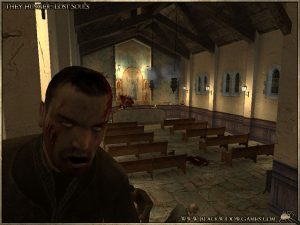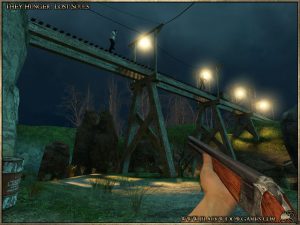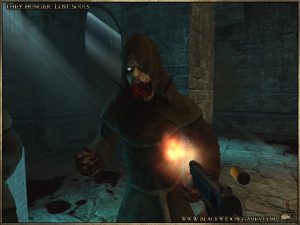They Hunger: Lost Souls is a canceled horror First-Person Shooter developed by Black Widow Games, exclusively for PC, from 2004 to 2008. It is a successor of They Hunger, a mod based on Half-Life.
They Hunger: Lost Souls was officially revealed in October 2005 by its developer:
Black Widow Games announced today the development of They Hunger: Lost Souls, its first commercial PC game powered by the award-winning Half-Life 2 Source engine from Valve Software. Based upon the highly popular They Hunger mod series, the upcoming title features a completely new horror-survival adventure. In North-Eastern Europe during the early 1960’s, strange anomalies culminate with dead corpses rising from their graves. As a tourist recovering from a tragic accident, you seek shelter in an ancient monastery overrun by bloodthirsty zombies, and become involved in an escalading cascade of calamities.
“They Hunger: Lost Souls is a first-person action game planned to take full advantage of the superior graphics, physics and new gameplay possibilities provided by the new Source technology,” said designer Neil Manke. “Without the previous technical restrictions of the now seven years old Half-Life 1 engine, we have been able to produce a brand new game far more exciting and creative than any simple sequel or remake could ever be. Fans of the original series should still recognize the basic gameplay style, although this is an independent story with no previous knowledge required.”
The new game is currently 75% complete after being secretly produced for almost a year, and a release date will be announced shortly. Regarding the adoption of a commercial model for this production, Neil explained “Next generation game engines are so complex and detailed that we would never be able to invest so much time and resources for such an ambitious project any other way. Right now we are still working out the pricing and distribution options, but our goal is a low cost alternative so it can be available for just a fraction of other commercial games.”
In the same month, Neil Manke, alongside Einar Saukas, were interviewed by Gamecloud:
Gamecloud – Why did you wish to use the Source engine from Half-Life 2 as the basis for your first game?
Neil Manke – Source is the only brush-based modern 3D game engine. In practice, it means a level designer can create interesting environments using mostly brushes, and later add special models to improve specific details. Working with brushes gives me much more flexibility and opportunity to improvise with my creativity. In comparison, most other state-of-the-art engines depend upon the rather slow and involved process of developing very specific models for every stage of architecture.
Gamecloud – What can you tell us about the back story for They Hunger: Lost Souls and how it relates to the previous They Hunger games?
Neil Manke – In the story, you are a tourist visiting North-Eastern Europe during the early 1960’s. After a dramatic, blood-curdling accident, you find yourself wandering alone in the wilderness and seek shelter in an ancient monastery. However, you soon realize things in this place of “sanctuary” are not what they should be. You then become involved in a desperate series of bone-chilling struggles to preserve your own life, and escape from this nightmarish experience.
Gamecloud – Where will the new game take place and what will the levels be like?
Neil Manke – Some of those locations have already been partially revealed in our first promotional images. Settings include: a huge ancient monastery complex comprised of many varied buildings, some clinging precariously to seaside cliffs, a zombie-infested salvage operation, an isolated farming settlement, wilderness areas with meandering river beds, lakes and waterfalls, fog shrouded swamps, and others. And there is still more to come.
Gamecloud – What new weapons can we expect to see in They Hunger: Lost Souls?
Einar Saukas – The weapons are similar to those in classic They Hunger, in the sense that they are a selection of era-relevant weapons, explosives and incendiaries. With the addition of a unique and innovative new weapon, the likes of which I can’t reveal to you, otherwise we will have to eliminate you and end this interview!
Gamecloud – What other new gameplay features will They Hunger: Lost Souls have?
Einar Saukas – There are many new gameplay features but obviously we can’t reveal much about them. For now I can only give you one example: One of the favorite features from the classic series was driving an old steam locomotive and flattening zombies with it. However, smarter zombies refuse to be such sitting ducks, so instead we decided to take advantage of realistic vehicle physics (provided by the Source engine) and give you a powerful tractor, that you can drive freely to chase the zombies down before running over them.
Gamecloud – Will this new game be episodic in nature like the previous They Hunger games?
Neil Manke – It is actually a fully independent game. However, we do have it planned as being the first game in a series. We already have a basic story outline for the sequels depending upon the reception of the first. Each game in the series is a complete story within itself, and each with an exciting and satisfying ending.
The game went into alpha in April 2006:
They Hunger: Lost Souls has now entered alpha stage. All level development is finished and refined. We are now focusing on final resources and content, which basically means integrating scripting, dialogues, additional models and animations.
However, in the following months, updates by Black Widow Games were pretty scarces. In October 2006, Saukas shared a little update about the development and told that various game models and animations were redesigned:
The game is now very close to release. From our previous screenshots, you can see the biggest issue we had was the lack of proper zombies. We were using “placeholder” models as temporary replacements for zombies during most of the development process, so we could continue working on other areas while we didn’t have enough people to model and animate new zombies. But in the last few months we were able to focus on the game pending issues, especially additional models and animations.
Our work is concentrated now on game improvements overall. There isn’t much left to do, but the game still needs lots of small details and tweaks that are very time consuming. We understand our fans are anxious to play it, but after about 2 years of development, it doesn’t make sense to rush its release now and sacrifice quality, when the game is so close to be finished. We still don’t have an official release date, but we can say it will be “very soon”.
In April 2007, an interview from Planet Half-Life clarified things a bit more:
Planet Half-Life: Ok, then … so what’s really going on?
Black Widow Games: Although we have never announced an official release date for They Hunger: Lost Souls (TH:LS), the truth is that our internal schedule had originally planned its release for end of 2006, but then we decided to delay it to implement further improvements.
It’s important to understand there’s a key difference between the original They Hunger, produced as a mod, and this new commercial game. A successful mod needs to be imaginative, very entertaining and have a good quality overall, but nobody expects a free mod to be flawless. In comparison, when someone buys a commercial game, the expectations are much higher. Players demand it to be polished in nearly every detail, and game developers have an obligation to provide this since they are getting paid to do so.
Planet Half-Life: The gaming landscape has changed, as it usually does, quite considerably in the time since we last spoke. Being big fans ourselves of zombie-themed games, our ears naturally pricked up when late last year Turtle Rock Studios announced the development of their new game, Left 4 Dead. Do you feel that you will be in direct competition with them, and what do you feel will set your game apart from theirs?
Black Widow Games: We are actually glad to have Left 4 Dead arriving around the same time as Lost Souls, because these two major titles based on the same zombie survival theme will probably attract much more attention together than each individual release.
As a matter of fact, the zombie genre is about all these titles have in common. L4D is a fast paced, adrenaline driven, pure action game focused on cooperation, where players have to always stick together to protect each other. If a player runs low on ammo, gets lost from his friends and surrounded by zombies, it’s game over for him… but that’s when Lost Souls begins.
Just like the original They Hunger series, Lost Souls is a horror game, where the player is expected to feel lonely, defenseless, and completely surrounded by zombies. Of course there’s also plenty of zombie killing as the player gradually finds out how to defend himself, but this is just part of the gameplay along with exploration, puzzle solving and story telling.
With L4D and Lost Souls based on opposite premises, there’s no possible comparison between these titles.
Planet Half-Life: Do you expect Lost Souls series to have more than three installments, or will this be a trilogy?
Black Widow Games: Lost Souls is the first chronicle and it’s composed of two episodes. The initial episode works as a “prelude” to the entire series, introducing all the story elements, a wide range of weapons, some of the key characters and all kinds of zombies. It has the player looking for shelter at an ancient monastery, where he can gradually learn basic zombie survival principles and the subtle art of killing the dead, all the while discovering some of the mystery about their origins. The following episode will introduce less conventional weapons and focus on exploring the surrounding areas, as well as revisiting the monastery.
The prelude episode will be released this year, and the next one just a few months later. In fact, we have already produced most of the second episode, but since there was too much content to be beta-tested and improved, we decided to focus our efforts to finish the initial episode earlier and release it in advance, instead of holding the game release until the entire chronicle was ready.
After that, unfortunately, everything went silent for Black Widow Games and They Hunger: Lost Souls. The game was mentionned on two issues from PC Gamer, the first one in August 2007, and the second one, a two pages preview, in March 2008. This was the latest news regarding the game before totally vanishing for an entire decade.
The rest of the story is a little weirder. In January 2015, a thread dedicated to the game on the Mapcore forum revealed some messages from one of the ex-developers, Teddy Bergsman Lind, on the project:
I was part of the team for a few years up until 2007/2008. At that time the game was about 60% finished, with 5-6 segments more or less done (the levels were huge). It should be stated Neil truly did a great job on the levels. I should still have the game anno 2008 on an old computer in a storage somewhere.
Everyone on the team, Neil and Einar included, pitched in in their spare time, and given the AAA scope of the project it was likely tricky business to sustain. Einar used to dream about starting up an actual dev studio to produce the game, and should there have been financial means I think it would have happened. Had Kickstarter been a thing back then, who knows. Our conversations eventually faded sometime in 2009; at that time to my knowledge the project was still alive, but I doubt it still is, at least as a commercial product.
I spoke with Einar for a while last night; he and Neil lost contact with each other years ago and have not been able to get back in touch since. There were some speculation Neil has been in bad health for a while. However, a few months ago Neil tried contacting Einar again. They weren’t able to get back in touch afterwards, so that’s the latest info there is. As far as project status goes though, it’s not cancelled. I think both of them are keen on getting back on track even after all these years.
In May 2019, builds coming from alpha and beta versions were leaked on ModDB.
To date, nothing has ever really been revealed about what happened during the development of They Hunger: Lost Souls. Through the various developer interviews, we can understand that Black Widow Games wanted to be perfect in the design of its first commercial game. Were the rumors that circulated about Neil Manke’s health true? Out of respect for Neil, Einar, and the rest of the Black Widow Games team, it’s perhaps best not wanting to know about it, and be grateful to have gotten, years later, the playable builds of They Hunger: Lost Souls, in order to appreciate their work.
Videos:
Full playthrough of the 2006 alpha:
Full Playthrough of the 2008 alpha:
Images before the redesign:
Images after the redesign:



